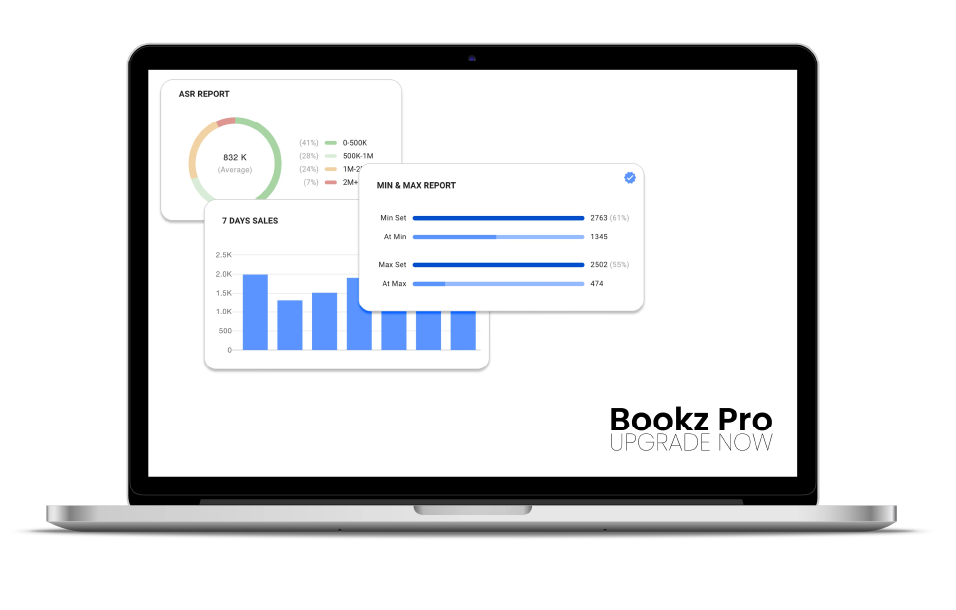What is Amazon Seller SKU: A Comprehensive Guide

Introduction: Amazon Seller SKU
Amazon Seller SKUs are a crucial component of any successful Amazon selling strategy. As an Amazon seller, understanding how to effectively use and manage your SKUs can make a significant difference in your business’s performance. Bookz Pro’s intuitive Amazon listing software empowers sellers with advanced SKU management features, making it easier than ever to optimize listings and streamline operations. In this comprehensive guide, we’ll dive deep into the world of Amazon Seller SKUs, exploring their importance, best practices, and how Bookz Pro can help you leverage them to take your sales to the next level.
What is Amazon Seller SKU?
Amazon Seller SKU (Stock Keeping Unit) is a unique identifier assigned by sellers to each product they offer on the platform. Unlike ASINs (Amazon Standard Identification Numbers), which are universal across all sellers for a specific item, Seller SKUs are created and managed by individual sellers. This allows for greater flexibility and control over inventory management, reporting, and product variations.
Why are Seller SKUs Important?
Using unique Seller SKUs offers several key benefits:
- Improved Inventory Management: By assigning distinct SKUs to each product or variation, you can easily track inventory levels, monitor sales performance, and make informed restocking decisions.
- Enhanced Reporting and Analytics: Seller SKUs enable you to generate detailed reports on individual product performance, profitability, and trends, helping you make data-driven business decisions.
- Simplified Product Variations: When selling products with multiple variations (e.g., size, color), unique SKUs allow for clearer organization and management of these variations within your inventory.
Best Practices for Creating Seller SKUs
To create effective Seller SKUs that streamline your operations, consider the following best practices:
- Keep it Simple: Use a clear, concise naming convention that is easy to understand and remember. Avoid using special characters or spaces, as these can cause issues with some inventory management systems.
- Incorporate Product Information: Include relevant product details within your SKU, such as brand, model, size, or color. This can make it easier to identify and manage products at a glance.
- Maintain Consistency: Ensure that your SKU naming convention is consistent across your entire product catalog. This will minimize confusion and make it easier for your team to work with your inventory.
Customized SKU Building with Bookz Pro
One of the standout features of Bookz Pro’s listing software is its customized SKU building functionality. This powerful tool allows you to embed crucial details directly into your SKUs, such as:
- Listed date
- Sales rank
- Average sales rank
- Fulfillment channel
- Condition
- Source
- Cost

Custom SKU Building on Bookz Pro, Amazon listing software
By incorporating this information into your SKUs, you gain a comprehensive understanding of each item at a glance, empowering you to make informed decisions quickly and easily.
Mapping Seller SKUs to ASINs
To ensure that your products are correctly listed and tracked on Amazon, it’s essential to map your Seller SKUs to the corresponding ASINs. This process involves associating your unique SKUs with the universal product identifiers recognized by Amazon. By doing so, you can:
- Avoid Duplicate Listings: Properly mapping your SKUs to ASINs prevents the creation of duplicate product listings, which can lead to confusion for both customers and Amazon’s systems.
- Improve Product Discoverability: Accurate SKU-to-ASIN mapping ensures that your products appear in relevant search results and categories, increasing their visibility to potential customers.
Managing Inventory with SKUs
Effective inventory management is crucial for the success of any Amazon seller. By leveraging your Seller SKUs, you can:
- Monitor Stock Levels: Regularly review your inventory levels by SKU to identify low-stock items and avoid stockouts.
- Set Reorder Points: Establish reorder points for each SKU based on sales velocity and lead times, ensuring that you always have sufficient stock on hand.
- Streamline Restocking: Use your SKUs to create purchase orders and communicate with suppliers, making the restocking process more efficient.
Optimizing Product Listings with SKUs
In addition to inventory management, Seller SKUs can also play a role in optimizing your product listings for search and discoverability. Consider the following:
- Consistent Usage: Ensure that your SKUs are consistently used across all aspects of your listings, including titles, descriptions, and images.
- Regular Updates: Keep your SKUs up-to-date to reflect any changes in your products, such as new variations or packaging updates.
Analyzing Sales Performance by Seller SKU

One of the most powerful aspects of using Seller SKUs is the ability to analyze sales performance at a granular level. By generating SKU-level reports, you can:
- Identify Top Performers: Pinpoint your best-selling SKUs and focus your efforts on promoting and optimizing these products.
- Spot Underperforming Items: Identify low-performing SKUs and make informed decisions about whether to optimize, bundle, or discontinue these products.
- Monitor Profitability: Calculate the profitability of each SKU by factoring in costs such as procurement, shipping, and Amazon fees.
Common SKU Mistakes to Avoid
While Seller SKUs offer numerous benefits, there are some common pitfalls to watch out for:
- Inconsistent Naming: Maintain a consistent naming convention across your SKUs to avoid confusion and ensure that your team can easily work with your inventory.
- Failure to Update: Regularly review and update your SKUs to reflect any changes in your products or business operations.
Importance of Having an Ultra-Fast Amazon Listing Software
Of course, you can do your listings on Seller Central. However, it may be very time-consuming and painful with a terrible UI. Without a doubt, there are many different business models on Amazon. Using an Amazon listing software like Bookz Pro becomes very crucial in terms of speed and efficiency, especially if you are regularly doing hundreds or even thousands of listings every month. An ultra-fast listing software definitely saves you time and effort in your regular listing process.
Book Reselling Tools
Bookz Pro offers a variety of software products for Amazon sellers, including an analytics dashboard, listing software, repricer, mobile application for scouting books, and inventory manager. Get a demo today, and we will help you streamline operations and increase revenue.
All in One Software
for Book Sellers
Scout Better – List Faster – Reprice Smarter
Over 30% Business Growth
Achieved by Our Clients

Conclusion
Amazon Seller SKUs are a powerful tool for any Amazon seller looking to optimize their listings, streamline inventory management, and boost sales. Bookz Pro’s intuitive listing software takes SKU management to the next level with its customized SKU building feature, enabling sellers to embed crucial product information directly into their SKUs. By understanding the importance of SKUs, implementing best practices, and leveraging Bookz Pro’s advanced features, you can unlock your full potential on the Amazon platform. Experience the power of Bookz Pro’s listing software firsthand with a free trial, and start optimizing your Amazon business today.
Frequently Asked Questions
Yes, Amazon allows sellers to create their own unique SKUs (Stock Keeping Units) for their products. When you list a product on Amazon, you have the option to assign your own SKU to each item. This is particularly useful if you already have an inventory management system in place or if you sell across multiple channels and want to keep your SKUs consistent.
You can easily find your unique SKU for each listing in your Seller Central account. Just go to the “Manage Inventory” section, and you’ll see the SKU displayed right next to the other important details about your product.
While SKUs (Stock Keeping Units) are an essential tool for Amazon sellers to manage and track their inventory, these unique alphanumeric codes assigned by sellers to their product listings cannot be used by customers to search for items on Amazon’s marketplace. The search results clearly indicate that SKUs are internal identifiers created by sellers for their own organizational and reporting purposes, but they are not a searchable field for buyers on Amazon’s website or mobile app. However, Amazon sellers can search SKUs on Seller Central’s “Manage Inventory” page.
Yes. Under the “Inventory” tab, you can locate the product listing you want to modify the SKU for and click “Edit Product Info”. This will allow you to change the SKU field along with editing other product details like price, condition, etc. However, it’s crucial to map the new SKU to the correct ASIN to avoid any listing errors or duplications.
Amazon allows sellers SKUs up to 40 characters, but creating excessively long codes can hinder readability and increase error risks. Shorter, well-structured SKUs enhance clarity, streamline processes, and minimize mistakes in inventory management and order fulfillment.
Yes, having a SKU (Stock Keeping Unit) is mandatory to sell products on Amazon. SKUs are a required field when creating new product listings on Amazon’s platform. Without assigning a unique SKU code to each product variation in your inventory, you cannot list items for sale on Amazon. SKUs act as critical identifiers that allow Amazon to track inventory levels, monitor sales performance, and associate your products with the correct detail pages. While you have the flexibility to create your own custom SKU codes or let Amazon generate them, providing a SKU is an essential prerequisite for any seller looking to list and sell products through Amazon’s marketplace.
The main difference between an SKU (Stock Keeping Unit) and an FNSKU (Fulfillment Network Stock Keeping Unit) on Amazon is their purpose and who generates them. An SKU is a unique code created by the seller to identify and track their product inventory internally. It is visible only in the seller’s account. On the other hand, an FNSKU is an Amazon-generated alphanumeric code directly linked to the seller’s SKU. It is used to identify and track the seller’s products within Amazon’s fulfillment network when using FBA (Fulfilled by Amazon). The FNSKU generates a barcode that the seller prints and affixes to their products before shipping to Amazon’s warehouses. So while an SKU is the seller’s internal tracking code, the FNSKU is Amazon’s way of associating the seller’s inventory with their fulfillment and logistics systems.
During the listing process, you’ll be prompted to enter a unique SKU, which you can generate yourself using any alphanumeric combination of up to 40 characters. It’s recommended to incorporate relevant product details like category, color, size, or style into the SKU format, such as “TS-RED-L” for a red t-shirt in large size. This structured approach not only enhances identification but also streamlines inventory management across sales channels. Avoid special characters, leading zeros, dates, or excessively long SKUs to minimize errors. You can either manually input your custom SKU or let Amazon auto-generate one. Consistently using the same SKU across listings, inventory systems, and sales platforms is crucial for accurate tracking and reporting within your Amazon seller business.



